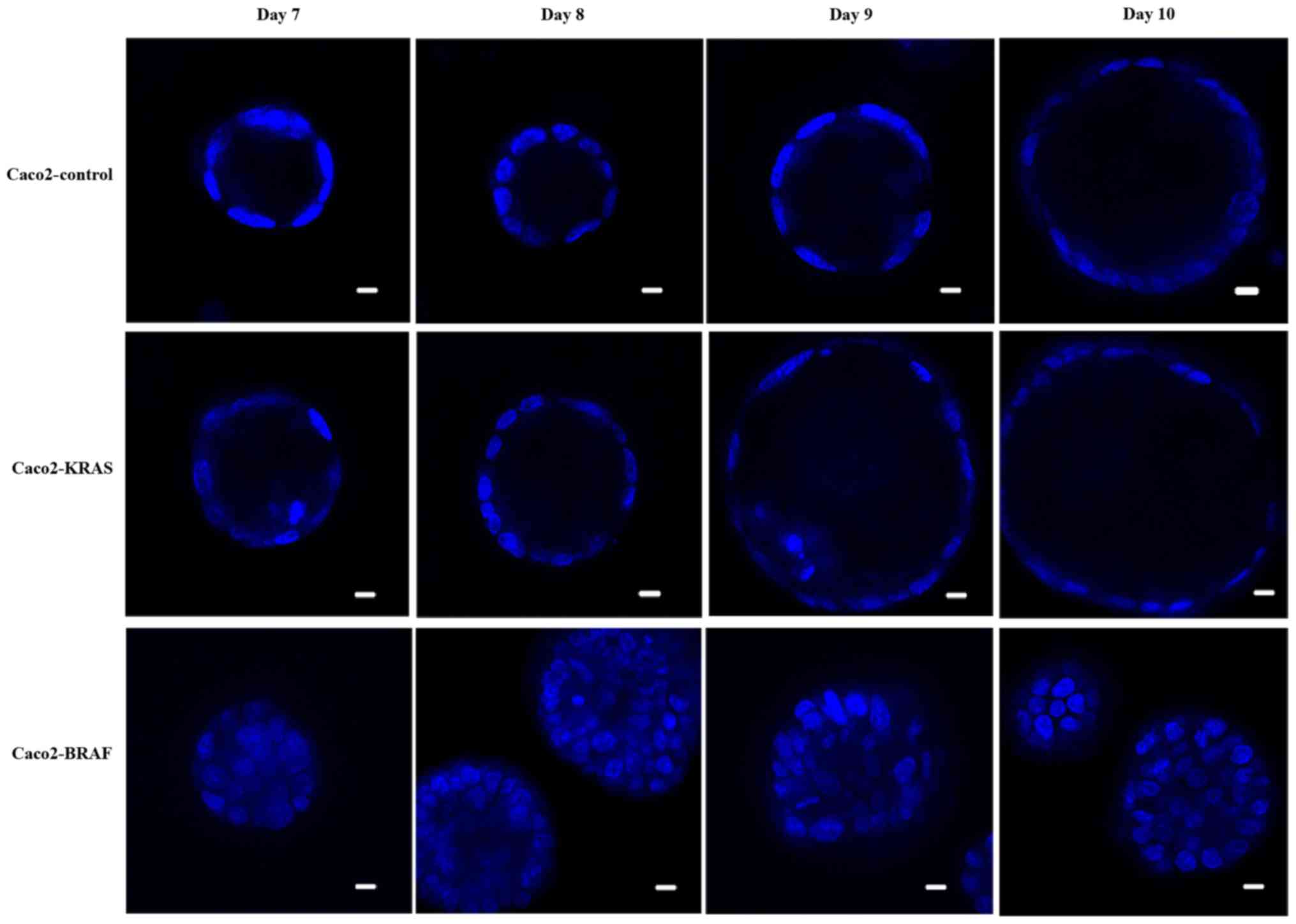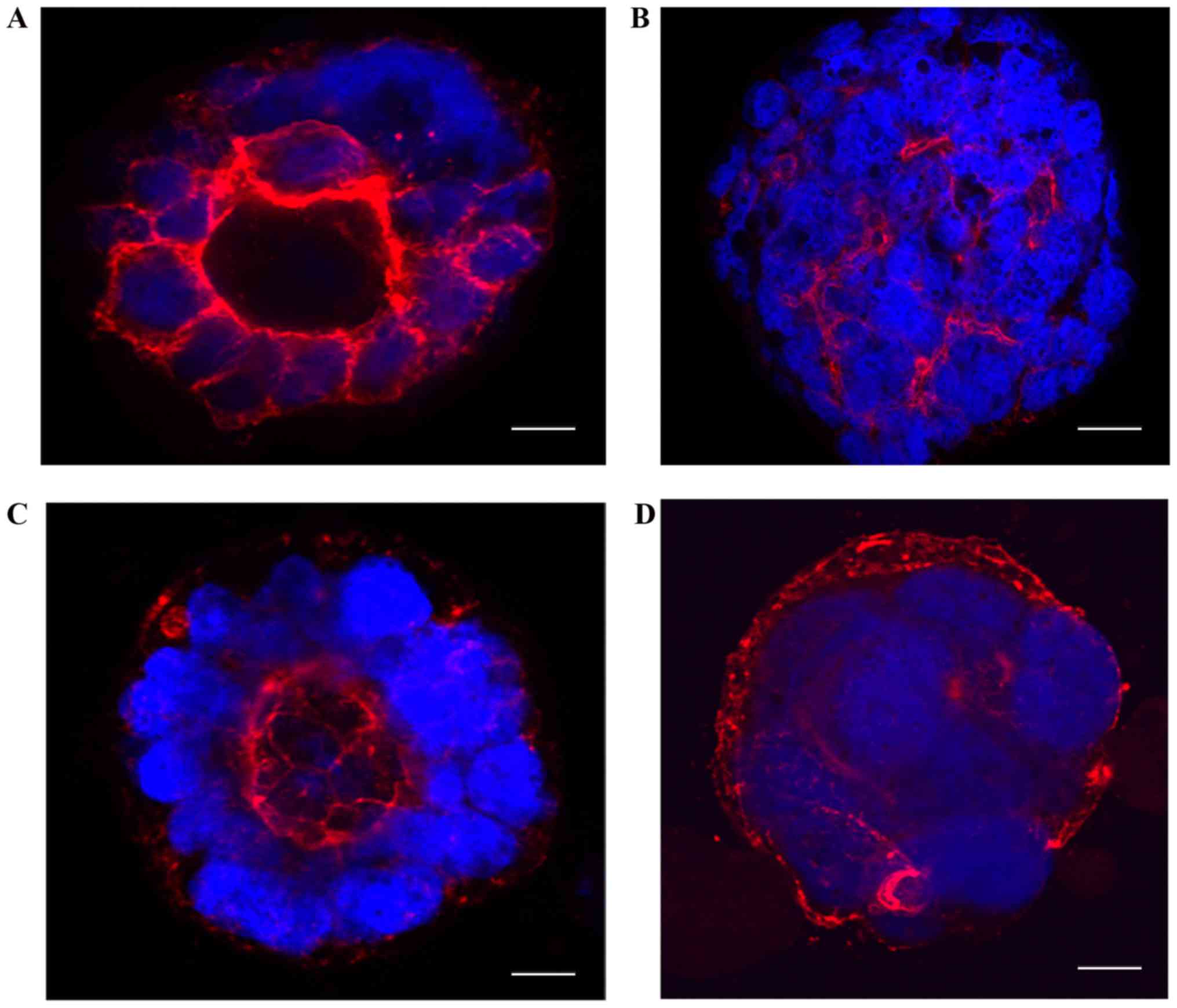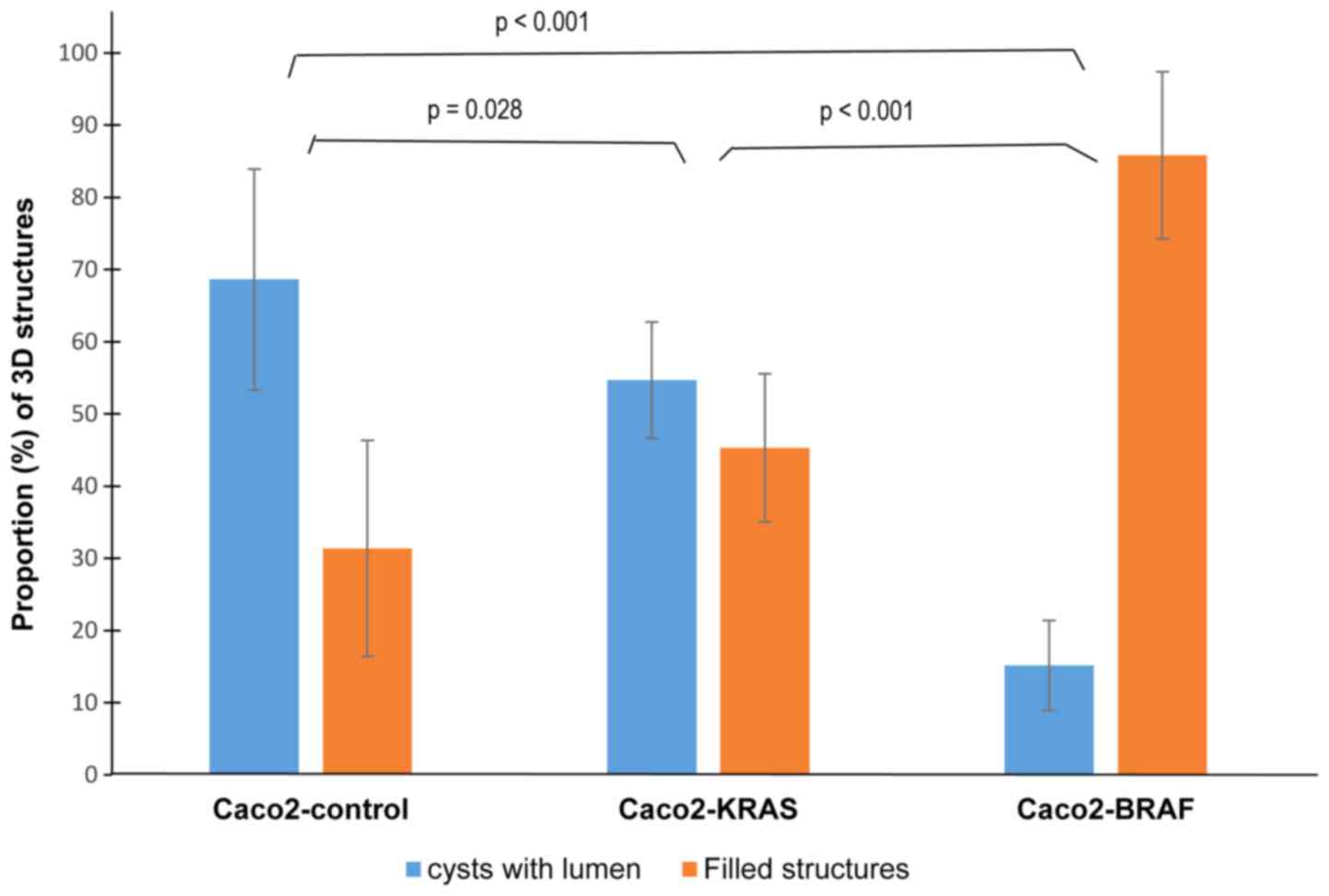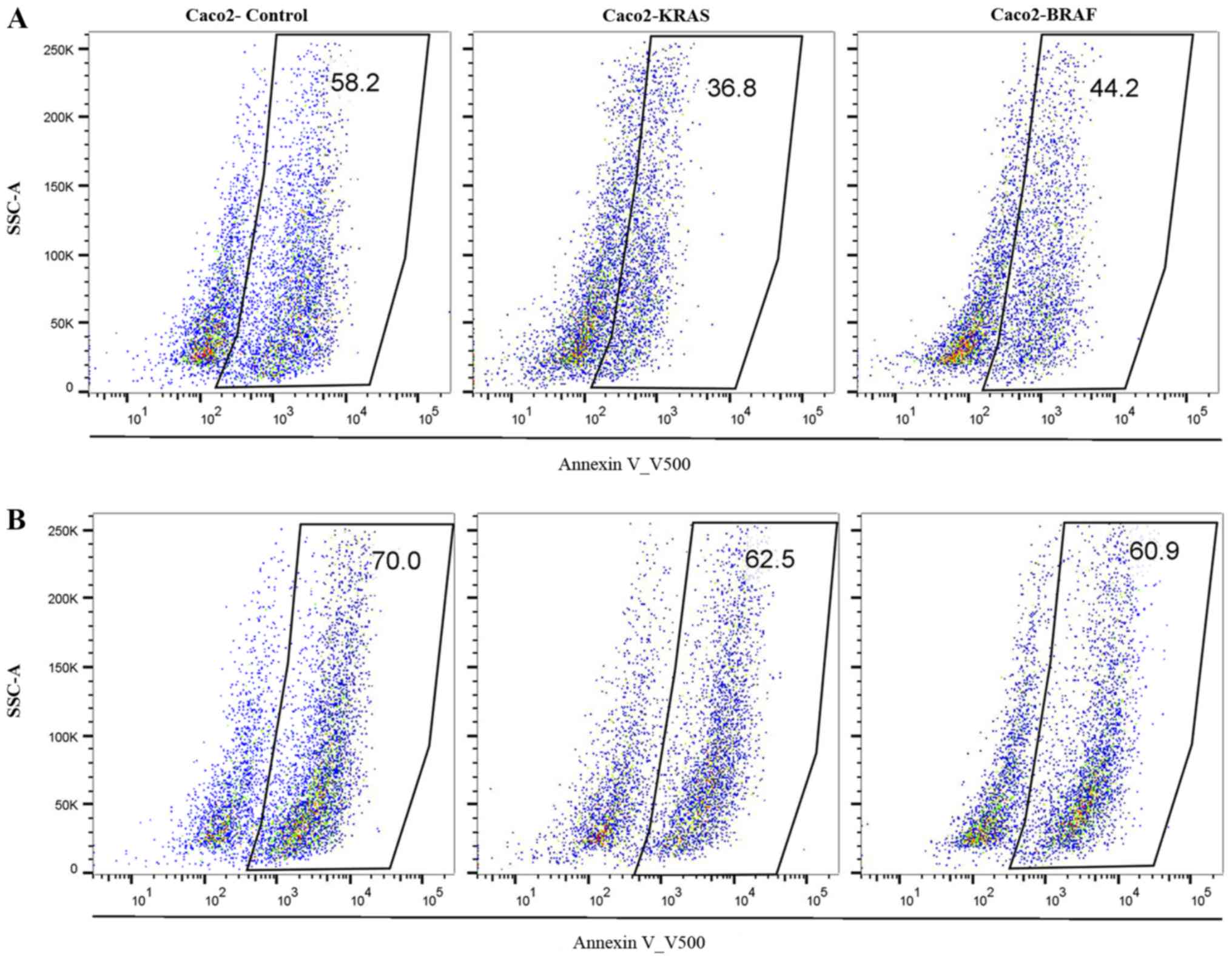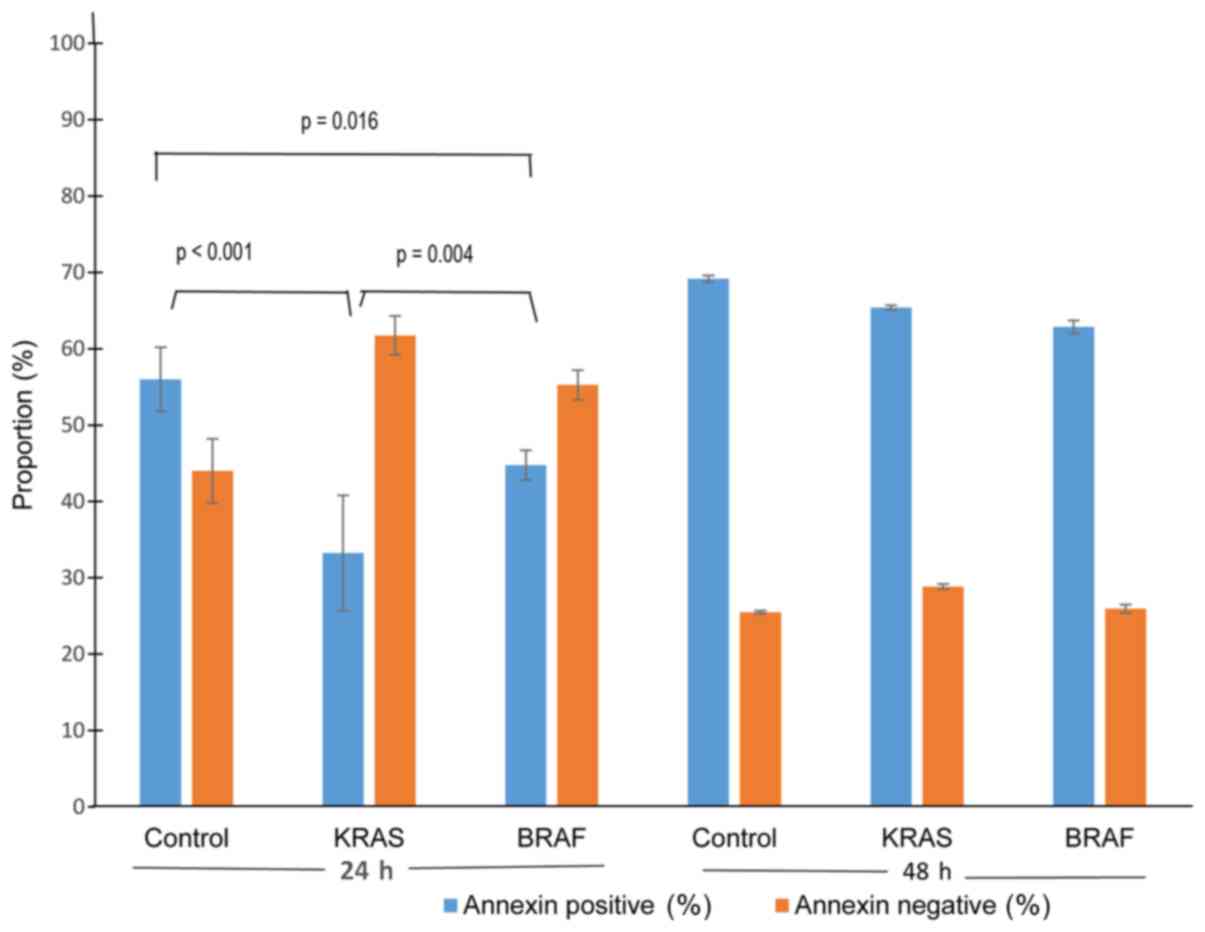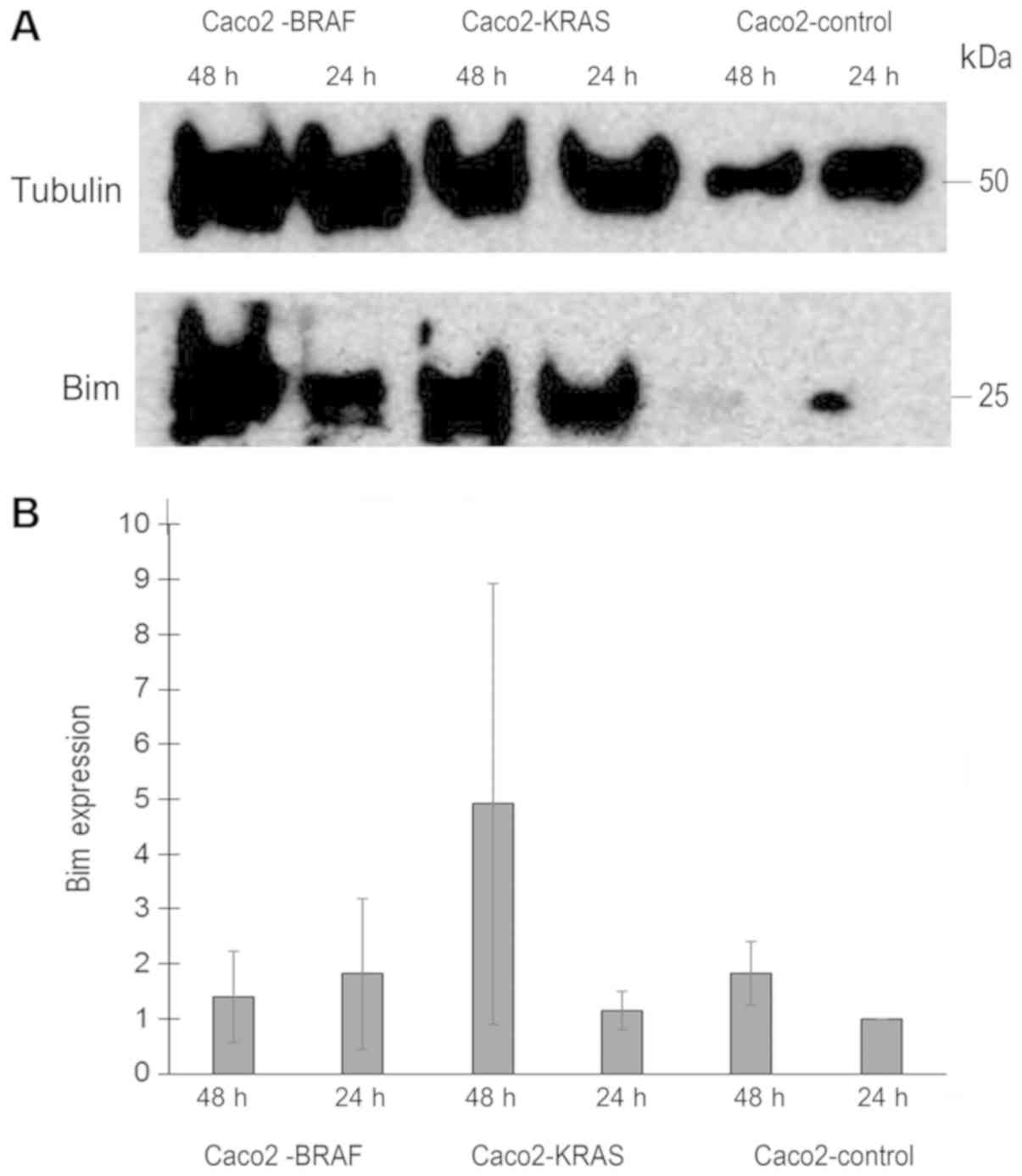|
1
|
Torre LA, Bray F, Siegel RL, Ferlay J,
Lortet-Tieulent J and Jemal A: Global cancer statistics, 2012. CA
Cancer J Clin. 65:87–108. 2015. View Article : Google Scholar : PubMed/NCBI
|
|
2
|
Arrington AK, Heinrich EL, Lee W, Duldulao
M, Patel S, Sanchez J, Garcia-Aguilar J and Kim J: Prognostic and
predictive roles of KRAS mutation in colorectal cancer. Int J Mol
Sci. 13:12153–12168. 2012. View Article : Google Scholar : PubMed/NCBI
|
|
3
|
Stefanius K, Ylitalo L, Tuomisto A,
Kuivila R, Kantola T, Sirnio P, Karttunen TJ and Mäkinen MJ:
Frequent mutations of KRAS in addition to BRAF in colorectal
serrated adenocarcinoma. Histopathology. 58:679–692. 2011.
View Article : Google Scholar : PubMed/NCBI
|
|
4
|
Neumann J, Zeindl-Eberhart E, Kirchner T
and Jung A: Frequency and type of KRAS mutations in routine
diagnostic analysis of metastatic colorectal cancer. Pathol Res
Pract. 205:858–862. 2009. View Article : Google Scholar : PubMed/NCBI
|
|
5
|
Foltran L, De Maglio G, Pella N, Ermacora
P, Aprile G, Masiero E, Giovannoni M, Iaiza E, Cardellino GG,
Lutrino SE, et al: Prognostic role of KRAS, NRAS, BRAF and PIK3CA
mutations in advanced colorectal cancer. Future Oncol. 11:629–640.
2015. View Article : Google Scholar : PubMed/NCBI
|
|
6
|
Guo F, Gong H, Zhao H, Chen J, Zhang Y,
Zhang L, Shi X, Zhang A, Jin H, Zhang J and He Y: Mutation status
and prognostic values of KRAS, NRAS, BRAF and PIK3CA in 353 chinese
colorectal cancer patients. Sci Rep. 8:60762018. View Article : Google Scholar : PubMed/NCBI
|
|
7
|
Matallanas D, Birtwistle M, Romano D,
Zebisch A, Rauch J, von Kriegsheim A and Kolch W: Raf family
kinases: Old dogs have learned new tricks. Genes Cancer. 2:232–260.
2011. View Article : Google Scholar : PubMed/NCBI
|
|
8
|
Yokota T, Ura T, Shibata N, Takahari D,
Shitara K, Nomura M, Kondo C, Mizota A, Utsunomiya S, Muro K and
Yatabe Y: BRAF mutation is a powerful prognostic factor in advanced
and recurrent colorectal cancer. Br J Cancer. 104:856–862. 2011.
View Article : Google Scholar : PubMed/NCBI
|
|
9
|
Lai E, Pretta A, Impera V, Mariani S,
Giampieri R, Casula L, Pusceddu V, Coni P, Fanni D, Puzzoni M, et
al: BRAF-mutant colorectal cancer, a different breed evolving.
Expert Rev Mol Diagn. 18:499–512. 2018. View Article : Google Scholar : PubMed/NCBI
|
|
10
|
Gilmore AP: Anoikis. Cell Death Differ. 12
(Suppl 2):S1473–S1477. 2005. View Article : Google Scholar
|
|
11
|
Guadamillas MC, Cerezo A and Del Pozo MA:
Overcoming anoikis-pathways to anchorage-independent growth in
cancer. J Cell Sci. 124:3189–3197. 2011. View Article : Google Scholar : PubMed/NCBI
|
|
12
|
Jinka R, Kapoor R, Sistla PG, Raj TA and
Pande G: Alterations in cell-extracellular matrix interactions
during progression of cancers. Int J Cell Biol. 2012:2191962012.
View Article : Google Scholar : PubMed/NCBI
|
|
13
|
Frisch SM and Ruoslahti E: Integrins and
anoikis. Curr Opin Cell Biol. 9:701–706. 1997. View Article : Google Scholar : PubMed/NCBI
|
|
14
|
Paoli P, Giannoni E and Chiarugi P:
Anoikis molecular pathways and its role in cancer progression.
Biochim Biophys Acta. 1833:3481–3498. 2013. View Article : Google Scholar : PubMed/NCBI
|
|
15
|
Demers MJ, Thibodeau S, Noël D, Fujita N,
Tsuruo T, Gauthier R, Arguin M and Vachon PH: Intestinal epithelial
cancer cell anoikis resistance: EGFR-mediated sustained activation
of Src overrides Fak-dependent signaling to MEK/Erk and/or
PI3-K/Akt-1. J Cell Biochem. 107:639–654. 2009. View Article : Google Scholar : PubMed/NCBI
|
|
16
|
Mason JA, Davison-Versagli CA, Leliaert
AK, Pape DJ, McCallister C, Zuo J, Durbin SM, Buchheit CL, Zhang S
and Schafer ZT: Oncogenic Ras differentially regulates metabolism
and anoikis in extracellular matrix-detached cells. Cell Death
Differ. 23:1271–1282. 2016. View Article : Google Scholar : PubMed/NCBI
|
|
17
|
Guerrero S, Casanova I, Farré L, Mazo A,
Capellà G and Mangues R: K-ras codon 12 mutation induces higher
level of resistance to apoptosis and predisposition to
anchorage-independent growth than codon 13 mutation or
proto-oncogene overexpression. Cancer Res. 60:6750–6756.
2000.PubMed/NCBI
|
|
18
|
Jones RP, Sutton PA, Evans JP, Clifford R,
McAvoy A, Lewis J, Rousseau A, Mountford R, McWhirter D and Malik
HZ: Specific mutations in KRAS codon 12 are associated with worse
overall survival in patients with advanced and recurrent colorectal
cancer. Br J Cancer. 116:923–929. 2017. View Article : Google Scholar : PubMed/NCBI
|
|
19
|
Boisvert-Adamo K and Aplin AE: Mutant
B-RAF mediates resistance to anoikis via bad and Bim. Oncogene.
27:3301–3312. 2008. View Article : Google Scholar : PubMed/NCBI
|
|
20
|
Goldstein NB, Johannes WU, Gadeliya AV,
Green MR, Fujita M, Norris DA and Shellman YG: Active N-Ras and
B-Raf inhibit anoikis by downregulating Bim expression in
melanocytic cells. J Invest Dermatol. 129:432–437. 2009. View Article : Google Scholar : PubMed/NCBI
|
|
21
|
Kawakami H, Huang S, Pal K, Dutta SK,
Mukhopadhyay D and Sinicrope FA: Mutant BRAF upregulates MCL-1 to
confer apoptosis resistance that is reversed by MCL-1 antagonism
and cobimetinib in colorectal cancer. Mol Cancer Ther.
15:3015–3027. 2016. View Article : Google Scholar : PubMed/NCBI
|
|
22
|
Patankar M, Vayrynen S, Tuomisto A,
Makinen M, Eskelinen S and Karttunen TJ: Micropapillary structures
in colorectal cancer: An anoikis-resistant subpopulation.
Anticancer Res. 38:2915–2921. 2018.PubMed/NCBI
|
|
23
|
Jia J, Zhang W, Liu JY, Chen G, Liu H,
Zhong HY, Liu B, Cai Y, Zhang JL and Zhao YF: Epithelial
mesenchymal transition is required for acquisition of anoikis
resistance and metastatic potential in adenoid cystic carcinoma.
PLoS One. 7:e515492012. View Article : Google Scholar : PubMed/NCBI
|
|
24
|
Fofaria NM and Srivastava SK: STAT3
induces anoikis resistance, promotes cell invasion and metastatic
potential in pancreatic cancer cells. Carcinogenesis. 36:142–150.
2015. View Article : Google Scholar : PubMed/NCBI
|
|
25
|
Cai Q, Yan L and Xu Y: Anoikis resistance
is a critical feature of highly aggressive ovarian cancer cells.
Oncogene. 34:3315–3324. 2015. View Article : Google Scholar : PubMed/NCBI
|
|
26
|
Herrmann D, Conway JR, Vennin C, Magenau
A, Hughes WE, Morton JP and Timpson P: Three-dimensional cancer
models mimic cell-matrix interactions in the tumour
microenvironment. Carcinogenesis. 35:1671–1679. 2014. View Article : Google Scholar : PubMed/NCBI
|
|
27
|
Edmondson R, Broglie JJ, Adcock AF and
Yang L: Three-dimensional cell culture systems and their
applications in drug discovery and cell-based biosensors. Assay
Drug Dev Technol. 12:207–218. 2014. View Article : Google Scholar : PubMed/NCBI
|
|
28
|
Weiswald LB, Bellet D and Dangles-Marie V:
Spherical cancer models in tumor biology. Neoplasia. 17:1–15. 2015.
View Article : Google Scholar : PubMed/NCBI
|
|
29
|
Fang Y and Eglen RM: Three-dimensional
cell cultures in drug discovery and development. SLAS Discov.
22:456–472. 2017.PubMed/NCBI
|
|
30
|
Langhans SA: Three-dimensional in vitro
cell culture models in drug discovery and drug repositioning. Front
Pharmacol. 9:62018. View Article : Google Scholar : PubMed/NCBI
|
|
31
|
Makrodouli E, Oikonomou E, Koc M, Andera
L, Sasazuki T, Shirasawa S and Pintzas A: BRAF and RAS oncogenes
regulate rho GTPase pathways to mediate migration and invasion
properties in human colon cancer cells: A comparative study. Mol
Cancer. 10:1182011. View Article : Google Scholar : PubMed/NCBI
|
|
32
|
Magudia K, Lahoz A and Hall A: K-Ras and
B-Raf oncogenes inhibit colon epithelial polarity establishment
through up-regulation of c-myc. J Cell Biol. 198:185–194. 2012.
View Article : Google Scholar : PubMed/NCBI
|
|
33
|
Debnath J, Muthuswamy SK and Brugge JS:
Morphogenesis and oncogenesis of MCF-10A mammary epithelial acini
grown in three-dimensional basement membrane cultures. Methods.
30:256–268. 2003. View Article : Google Scholar : PubMed/NCBI
|
|
34
|
Camplejohn RS: Flow cytometric measurement
of cell proliferation. Methods Mol Med. 57:133–143. 2001.PubMed/NCBI
|
|
35
|
Pinto MP, Jacobsen BM and Horwitz KB: An
immunohistochemical method to study breast cancer cell
subpopulations and their growth regulation by hormones in
three-dimensional cultures. Front Endocrinol (Lausanne). 2:152011.
View Article : Google Scholar : PubMed/NCBI
|
|
36
|
Kozlova NI, Morozevich GE, Chubukina AN
and Berman AE: Integrin alphavbeta3 promotes anchorage-dependent
apoptosis in human intestinal carcinoma cells. Oncogene.
20:4710–4717. 2001. View Article : Google Scholar : PubMed/NCBI
|
|
37
|
Cremolini C, Di Maio M, Petrelli F,
Berenato R, Loupakis F and Pietrantonio F: BRAF-mutated metastatic
colorectal cancer between past and future. Br J Cancer.
113:1634–1635. 2015. View Article : Google Scholar : PubMed/NCBI
|
|
38
|
Orlandi A, Calegari A, Inno A, Berenato R,
Caporale M, Niger M, Bossi I, Di Bartolomeo M, de Braud F and
Pietrantonio F: BRAF in metastatic colorectal cancer: The future
starts now. Pharmacogenomics. 16:2069–2081. 2015. View Article : Google Scholar : PubMed/NCBI
|
|
39
|
Pollan SG, Huang F, Sperger JM, Lang JM,
Morrissey C, Cress AE, Chu CY, Bhowmick NA, You S, Freeman MR, et
al: Regulation of inside-out β1-integrin activation by CDCP1.
Oncogene. 37:2817–2836. 2018. View Article : Google Scholar : PubMed/NCBI
|
|
40
|
Zhang X, Cromwell JW, Kunjummen BD, Yee D
and Garcia-Aguilar J: The alpha2 and alpha3 integrins are required
for morphologic differentiation of an intestinal epithelial cell
line. Surgery. 133:429–437. 2003. View Article : Google Scholar : PubMed/NCBI
|
|
41
|
Zajac O, Raingeaud J, Libanje F, Lefebvre
C, Sabino D, Martins I, Roy P, Benatar C, Canet-Jourdan C, Azorin
P, et al: Tumour spheres with inverted polarity drive the formation
of peritoneal metastases in patients with hypermethylated
colorectal carcinomas. Nat Cell Biol. 20:296–306. 2018. View Article : Google Scholar : PubMed/NCBI
|
|
42
|
Clarke CN and Kopetz ES: BRAF mutant
colorectal cancer as a distinct subset of colorectal cancer:
Clinical characteristics, clinical behavior, and response to
targeted therapies. J Gastrointest Oncol. 6:660–617.
2015.PubMed/NCBI
|
|
43
|
Jang MH, Kim S, Hwang DY, Kim WY, Lim SD,
Kim WS, Hwang TS and Han HS: BRAF-mutated colorectal cancer
exhibits distinct clinicopathological features from wild-type
BRAF-expressing cancer independent of the microsatellite
instability status. J Korean Med Sci. 32:38–46. 2017. View Article : Google Scholar : PubMed/NCBI
|
|
44
|
Li Y and Li W: BRAF mutation is associated
with poor clinicopathological outcomes in colorectal cancer: A
meta-analysis. Saudi J Gastroenterol. 23:144–149. 2017.PubMed/NCBI
|
|
45
|
Modest DP, Ricard I, Heinemann V,
Hegewisch-Becker S, Schmiegel W, Porschen R, Stintzing S, Graeven
U, Arnold D, von Weikersthal LF, et al: Outcome according to KRAS-,
NRAS- and BRAF-mutation as well as KRAS mutation variants: Pooled
analysis of five randomized trials in metastatic colorectal cancer
by the AIO colorectal cancer study group. Ann Oncol. 27:1746–1753.
2016. View Article : Google Scholar : PubMed/NCBI
|
|
46
|
Fu T, Guzzetta AA, Jeschke J, Vatapalli R,
Dave P, Hooker CM, Morgan R, Iacobuzio-Donahue CA, Liu B and Ahuja
N: KRAS G>A mutation favors poor tumor differentiation but may
not be associated with prognosis in patients with curatively
resected duodenal adenocarcinoma. Int J Cancer. 132:2502–2509.
2013. View Article : Google Scholar : PubMed/NCBI
|
|
47
|
Margonis GA, Kim Y, Spolverato G, Ejaz A,
Gupta R, Cosgrove D, Anders R, Karagkounis G, Choti MA and Pawlik
TM: Association between specific mutations in KRAS codon 12 and
colorectal liver metastasis. JAMA Surg. 150:722–179. 2015.
View Article : Google Scholar : PubMed/NCBI
|
|
48
|
Wickenden JA, Jin H, Johnson M, Gillings
AS, Newson C, Austin M, Chell SD, Balmanno K, Pritchard CA and Cook
SJ: Colorectal cancer cells with the BRAF(V600E) mutation are
addicted to the ERK1/2 pathway for growth factor-independent
survival and repression of BIM. Oncogene. 27:7150–7161. 2008.
View Article : Google Scholar : PubMed/NCBI
|
|
49
|
Gogada R, Yadav N, Liu J, Tang S, Zhang D,
Schneider A, Seshadri A, Sun L, Aldaz CM, Tang DG and Chandra D:
Bim, a proapoptotic protein, up-regulated via transcription factor
E2F1-dependent mechanism, functions as a prosurvival molecule in
cancer. J Biol Chem. 288:368–381. 2013. View Article : Google Scholar : PubMed/NCBI
|
|
50
|
Teräväinen TP, Myllymäki SM, Friedrichs J,
Strohmeyer N, Moyano JV, Wu C, Matlin KS, Muller DJ and Manninen A:
αV-integrins are required for mechanotransduction in MDCK
epithelial cells. PLoS One. 8:e714852013. View Article : Google Scholar : PubMed/NCBI
|
|
51
|
Ferreira LP, Gaspar VM and Mano JF: Design
of spherically structured 3D in vitro tumor models-advances and
prospects. Acta Biomater. 75:11–34. 2018. View Article : Google Scholar : PubMed/NCBI
|
|
52
|
Stevens PD, Wen YA, Xiong X, Zaytseva YY,
Li AT, Wang C, Stevens AT, Farmer TN, Gan T, Weiss HL, et al: Erbin
suppresses KSR1-mediated RAS/RAF signaling and tumorigenesis in
colorectal cancer. Cancer Res. 78:4839–4852. 2018. View Article : Google Scholar : PubMed/NCBI
|
|
53
|
Riedl A, Schlederer M, Pudelko K, Stadler
M, Walter S, Unterleuthner D, Unger C, Kramer N, Hengstschlager M,
Kenner L, et al: Comparison of cancer cells in 2D vs 3D culture
reveals differences in AKT-mTOR-S6K signaling and drug responses. J
Cell Sci. 130:203–218. 2017. View Article : Google Scholar : PubMed/NCBI
|
|
54
|
Luca AC, Mersch S, Deenen R, Schmidt S,
Messner I, Schäfer KL, Baldus SE, Huckenbeck W, Piekorz RP, Knoefel
WT, et al: Impact of the 3D microenvironment on phenotype, gene
expression, and EGFR inhibition of colorectal cancer cell lines.
PLoS One. 8:e596892013. View Article : Google Scholar : PubMed/NCBI
|
|
55
|
Derouet M, Wu X, May L, Hoon Yoo B,
Sasazuki T, Shirasawa S, Rak J and Rosen KV: Acquisition of anoikis
resistance promotes the emergence of oncogenic K-ras mutations in
colorectal cancer cells and stimulates their tumorigenicity in
vivo. Neoplasia. 9:536–545. 2007. View Article : Google Scholar : PubMed/NCBI
|















